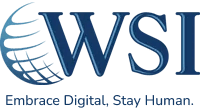Whether you are starting a new business or have an established company that wants to remain competitive in the market, having a robust business and growth strategy provides a base on which all operations can be built and future expansion plans can be set up.
With nearly thirty years of experience, WSI understands the intricacies of creating and executing fruitful strategies for businesses. To help you navigate this critical process, we’ve developed a comprehensive guide that outlines the essential components of a business strategy framework. This guide showcases how WSI’s deep industry knowledge can empower you to develop and execute a winning strategy for your organization.
Let’s dive in!
Key Components of a Strong Business Strategy Framework
A robust business strategy provides a structured approach to defining and achieving organizational goals. It involves understanding your market, accurately evaluating resources, and making a plan that fits well with all parts of the business. Here are the essential components:
Initial Assessment
The initial assessment is critical for developing your business strategy. It involves a comprehensive analysis of your current operations, market position, and competitive landscape. This stage lays the foundation for all future planning, ensuring that your strategy is grounded in factual insights.
Gather
This stage involves collecting all relevant data about your business, including financial performance, market trends, customer information, and competitor analysis. This information serves as the foundation for understanding your business’s current position.
Understand
Examine the data you have collected. What are your organization’s strengths? Weaknesses? Where is the competition overtaking you? This process is known as SWOT analysis. It helps you recognize your business’s strengths, areas for growth, possibilities, and threats.
Assess
Now that you’ve considered all the numbers (the good, the bad, and the ugly!), it’s time to look at everything you currently have in place, such as your workforce, technology, and operational efficiencies. By evaluating these factors, you can determine the gaps that must be filled to reach your business’s strategic goals.
Strategize
Now that you have a solid understanding of your business, the next step is to develop a strategy that aligns with your business goals and market opportunities. This involves setting distinct, quantifiable targets and outlining the actions required to achieve them.
Prioritize, Define Projects, and Set KPIs
Prioritize what you aim to accomplish with your business plan, such as expanding the market, increasing earnings, creating new products, or improving operations. Develop a list of projects that outline the steps to achieve prioritized goals. Establish key performance indicators (KPIs) to measure the success of each project and ensure alignment with your overall objectives.
Align Resources
Check if your resources, such as budget, people, and technology, align with the strategic objectives. This is where the rubber meets the road and where you need to ensure that your goals can have a chance of success. This could mean changing budget assignments, giving workers new skills, or investing in new technologies.
Implement and Monitor
No battle plan survives contact with the enemy. That’s why you need to check progress frequently. Use key performance indicators (KPIs) to gauge achievement and make alterations when necessary to maintain alignment with the strategy.
Common Challenges and How to Overcome Them
WSI understands that crafting a unique business strategy can be complicated. Markets and trends change, competitors advance, and new technologies disrupt the marketplace.
This is why our years of expertise and experience make us stand out—we’ve seen it all! In fact, here are a few common problems that your business might encounter and how WSI can help you overcome them:
- Lack of a Clear Vision: Many businesses need help stating their long-term goals. All business owners say they want to make more money—but how do you make that happen? WSI can assist in expressing a clear vision and creating attainable objectives for your business.
- Data Overload: Analysis paralysis is a very real problem. When there is too much data, it can be challenging to prioritize and know what’s most important. Our business strategy and digital marketing experts help separate valuable information from all other noise and concentrate on key understandings.
- Resource Constraints: A scarcity of resources might impede your strategy’s execution. We help you maximize the use of your current resources and find economical options.
- Market Dynamics: Business environments constantly change, and keeping up with the latest trends can be difficult. WSI provides continuous support when adjusting and maintaining your competitive edge.
5 Critical Components of Business Strategy Often Overlooked
A comprehensive business strategy involves many moving parts. While many business owners focus on the big picture, several key components are frequently overlooked but can significantly impact the success of their strategic planning.
Initial Business Assessment (IBA)
Before tackling strategy development, it’s essential to conduct a thorough review of your company’s history, current business state, and goal prioritization. The Initial Business Assessment (IBA) serves as the foundation for all strategic planning. It involves comprehensively reviewing your company’s history, current business state, and future goals. This assessment typically includes:
- Company History: Analyzing past successes, failures, and pivotal moments
- Business Review: Evaluating current operations, market position, and financial health
- Objectives, Timeline, and Budget: Understanding current objectives and resources
A thorough IBA provides a clear starting point and helps identify areas of focus for your strategy.
Product/Service Value Proposition
Your value proposition is the core of your business offering. It’s what sets you apart from competitors and attracts customers. While most businesses have a general idea of their offering’s value, a detailed analysis of your product or service’s unique value proposition can uncover new competitive advantages and marketing opportunities.
Developing a strong value proposition involves:
- Identifying your target audience’s needs and pain points
- Clearly articulating how your product or service solves these problems
- Highlighting unique features or benefits that differentiate you from competitors
- Aligning your value proposition with your brand identity and overall business strategy
A well-defined value proposition guides product development, marketing efforts, and customer engagement strategies.
Website, CRO, and SEO Audit
In today’s digital landscape, your online presence can make or break your business. A comprehensive audit of your website’s performance, conversion rate optimization (CRO), and search engine optimization (SEO) can reveal untapped growth potential. A comprehensive audit includes:
- Website Performance: Assessing load times, mobile responsiveness, and user experience
- Conversion Rate Optimization (CRO): Analyzing user behavior and identifying opportunities to increase conversions
- Search Engine Optimization (SEO): Evaluating your site’s visibility in search results and developing strategies to improve rankings
This audit can reveal critical improvements that boost your online presence and drive business growth.
Customer Empathy Mapping
Understanding your customers goes beyond basic demographics. Creating a detailed empathy map helps you understand their needs, pain points, and motivations deeper, leading to more effective product development and marketing strategies. Customer empathy mapping involves:
- Identifying what customers think, feel, say, and do about your product or service
- Uncovering hidden needs, desires, and pain points
- Mapping the customer journey to identify key touchpoints and opportunities for improvement
- Using these insights to inform product development, marketing, and customer service strategies
This deep understanding of your customers can lead to more targeted and effective business strategies.
Brand Narrative and Content Strategy
Many businesses underestimate the power of a cohesive brand story. A compelling brand narrative and aligned content strategy can significantly enhance customer engagement and loyalty. This involves:
- Developing a transparent and authentic brand story that resonates with your target audience
- Crafting a consistent brand voice across all communication channels
- Creating a content strategy that supports your brand narrative and business goals
- Aligning your content with the customer journey to provide value at every stage
A strong brand narrative and content strategy can differentiate your business in a crowded market and foster deeper connections with your audience.
Focusing on these often-overlooked components can help businesses develop a more comprehensive and effective strategy. Remember, successful strategy implementation requires ongoing assessment and adjustment. Regularly revisiting these components can help ensure your business stays on track and adapts to changing market conditions.
Benefits of Using WSI’s Business Strategy Framework
At WSI, our Consultants use our vast knowledge and reliable methods to assist businesses in creating and executing effective strategies. This is the way our system can help your organization:
- Tailored Solutions: We understand that each business has its own characteristics. That’s why we don’t believe in a one-size-fits-all approach. Our adaptable structure can be adjusted to fit your precise requirements and goals.
- Expert Assistance: Our Consultants, having worked in this field for nearly 30 years, provide profound industry understanding and perspectives for your strategic planning.
- Comprehensive Methodology: We can help you from the beginning of evaluation to putting it into action, giving complete assistance for all parts of your strategy.
- Sustainable Growth: We concentrate on helping you attain continual success. We assist in formulating plans that not only produce swift outcomes but also position you for sustained growth.
Plans are Nothing; Planning is Everything
Success planning is not only about establishing goals and creating vision boards but also about developing a top-to-bottom strategy for your business. WSI’s Consultants can offer the knowledge and resources necessary for an effective business strategy that promotes expansion and enduringness. Whether you are beginning this journey or want to enhance your existing plan, we have a successful framework and AI Business Analysis tool to assist in all phases of building strategies.
Speak with WSI now to understand more about how we can aid you in achieving your business goals and successfully moving through the digital future.

Jukka founded WSI Web Enhancers in 2012. His progressive and pioneering SEO approaches help businesses increase traffic while improving conversion rates. As an accomplished digital marketing authority, he spins effective web design, SEO, and social media engagement into winning strategies for local and national companies.






